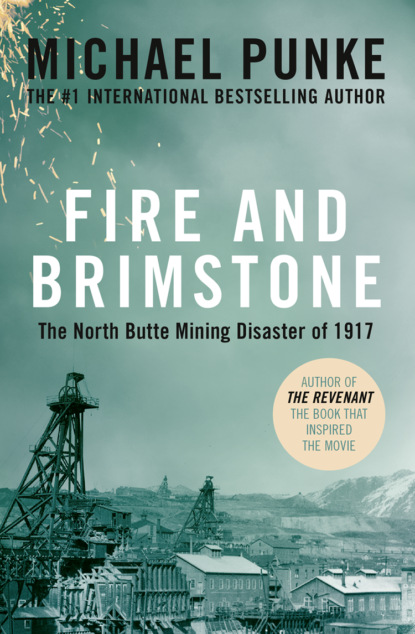По всем вопросам обращайтесь на: info@litportal.ru
(©) 2003-2024.
✖
Fire and Brimstone: The North Butte Mining Disaster of 1917
Настройки чтения
Размер шрифта
Высота строк
Поля
Forgotten for a time, though the riot offered a preview of the broader ramifications of the disaster that was about to erupt—a disaster that would envelop Wheeler’s long career in ways that he could not possibly foresee.
As they ascended the shaft, the members of the cable crew no doubt felt a mixture of relief and trepidation. They knew they were lucky to be alive, but there would be serious consequences for their role in ruining a valuable piece of mine property. The cable cost more than $5,000—the equivalent of a year’s wage for four men.
What the cable crew could not know was that the events they had set in motion would stretch far beyond a $5,000 electrical wire. In less than two hours, hundreds of men would be locked in a desperate struggle to survive. In less than three days, 163 of them would be dead.
Nor would the death and destruction be limited to the mines.
Before the last chapter was written, the legacy of the disaster would include murder, a crippling strike, an ethnic and political witch hunt, a national law effectively suspending the First Amendment, and an epic battle over presidential power. Butte, Montana, sits in the heart of the American West—but this is the story of a very different frontier.
Daylight had come and gone when the cable crew reached the surface, late in the evening of June 8, 1917. The men reported the lost cable to Ernest Sullau, the assistant foreman. Sullau had just arrived at work, and the responsibility for pulling the ruined cable from the shaft would fall to him. Mine operations ran round the clock, and Sullau headed up the graveyard shift.
Two (#ulink_7f742f7c-7845-5da5-9bf4-d01d01e60a5d)
“LIKE A GIGANTIC TORCH” (#ulink_7f742f7c-7845-5da5-9bf4-d01d01e60a5d)
An appalling sight which caused the strongest hearts to quail was the cremation of two men, Mike Conway [sic] and [Peter]Sheridan, station tenders, who were trapped like rats in a double decked cage, about twenty feet above the collar of the shaft, with the flames flying from the shaft like a gigantic torch around them.
—BUTTE MINER, JUNE 9, 1917
The miners who worked for forty-eight-year-old Ernest Sullau called him “Sully.” Just about everybody in Butte, it seems, had a nickname.
Sullau was born in Hamburg, Germany, on Christmas Day 1868. He came to America as a “small boy” and spent most of his adult life as a miner, including stints chasing gold in Klondike and Nome. When he arrived in Montana around 1897, he first worked as a placer miner—sifting small claims of his own. By 1900, though, Sullau gave up his quest for the big strike, opting instead for the steady wages of industrial mining. By 1917, he was a seasoned, fifteen-year veteran of the North Butte Mining Company’s Speculator and Granite Mountain mines.
While Sullau never got rich, the stability he found in Butte’s mines brought him other benefits. In 1911, at the age of forty-two, Sullau married Lena Benson, a woman unabashed in her affection for her husband. “He was the best man that ever lived,” she said. “When the twenty-to-six car came I knew he would be on it.” Through his hard work and experience with the North Butte Mining Company, Sullau had risen to the rank of assistant foreman. Between his respected position in the mine and his comfortable home life, Sullau had reached a “good place in life.”
Sullau’s task on the evening of June 8, 1917, was straightforward: Descend the mine in the auxiliary cage (which was not blocked by the ruined cable); find the top end of the cable; attach it to a hoisting rope; and pull it up. With the cable removed, an assessment could be made of the damage done to the shaft.
Already it was clear that the water supply to the lower reaches of Granite Mountain had been severed. Without water, the miners’ Leyner drills could not function. The men at the 3,000 level, unable to work, had gone home, no doubt grumbling about the wages they lost in a workday cut short.
Accompanying Sullau into the mine were a shift boss named John “Baldy” Collins and two shaft men. It was 11:30 P.M. when the four men crowded into the open cage and began their descent. Their destination was a point fifty feet below the 2,400 Station—where the top portion of the electrical cable had lodged.
The ride down, covering nearly half a mile, would have taken around five minutes. When the men finally came even with the tangled mass, there was no sign of the end of the cable. To search for it, Sullau and Baldy crawled out of the cage—edging perilously along the timbers on the side and center of the shaft. Sullau went one direction and Baldy went the other—with the web of cable in between them.
The Granite Mountain shaft measured 3,740 feet from top to bottom—the deepest in Butte. Though already 2,450 feet below the surface, the men were still a gut-churning 1,300-foot drop above the bottom of the shaft. Their position was the equivalent of hanging from the top of the Empire State Building—in the dark.
As Sullau gripped the shaft timbers, he also held tight to the carbide-burning lantern that every miner was required to buy. Though electric headlamps had been available since the turn of the century (and were widely used in coal mines), carbide lanterns saw far wider use through the 1920s. Improvements to electric lamps in the 1930s would make them brighter and less heavy, but before then, the weight of the batteries made them so bulky that miners didn’t like to carry them.
So as Ernest Sullau searched for the end of the ruined cable at 11:45 P.M., he held in his hand an open flame—not even a pane of glass enclosed the fire. The environment could hardly have been more volatile. The fall of the giant cable had scraped away half of its lead sheathing, exposing large sections of the highly flammable, oil-soaked cloth that insulated the wire. Boys who lived near the mines picked up scraps of this same type of electrical cable, stripping them to sell for the copper. The boys used their pocketknives to peel off the lead. To clean away the cloth, though, they simply touched it with a match. It burned “like gasoline.”
Somehow, as Sullau clung to the timbers, probing into the darkness, his lantern came into contact with the exposed cloth on the cable. It burst into flames. Reflexively, Sullau recoiled his lantern arm—sparking a second set of flames behind him.
“John!” Sullau yelled to Baldy. “I got my lamp too close!”
Baldy clambered around to Sullau’s position and the two men worked furiously to stamp out the first set of flames. For an instant it seemed to work. But then, remembered Baldy, the fire “immediately broke out in the cable on the opposite side.” Furiously they flailed at this second outbreak, but the fire by now was taking on a life of its own.
The flames spread rapidly through the tangled cable, the frayed wire like a 1,200-foot fuse. To make matters worse, the Granite Mountain shaft had a powerful downdraft. Under normal circumstances, air circulated down the Granite Mountain shaft, then traveled sideways through numerous “crosscuts” to its sister shaft, the Speculator. The Spec, an updraft, drew the air back up to the surface. Air in this system moved at a breezy 200 to 300 feet per minute, making the Granite Mountain and Speculator shafts among the best ventilated in Butte.
This circulation, normally beneficial, now turned deadly. In the initial moments after flames broke out, the Granite Mountain downdraft sucked the fire into the mass of cable, then fanned the growing conflagration.
Sullau and Baldy, fearful for their lives, scrambled back in the cage, signaling the surface furiously to be lifted up to the 2,400 Station. The cage responded at once—pulling them up fifty feet to the station. A blunt-faced, big-handed miner named Albert Cobb was one of several men working at the 2,400 that night. “I had just pulled out of the 2,400 of the Granite Mountain with a load of rock.”
Sullau threw open the cage door and jumped out. Baldy, remaining in the cage, signaled the surface to pull him and the two other men to the top. The cage disappeared as Sullau yelled desperately to Albert Cobb, “Give me your bucket quick.”
Another man in the station knocked the top off of a ten-gallon drinking keg and carried it toward the shaft. The fire, though, was already far beyond buckets. “Before we could get over to the shaft,” Cobb would later report, “the smoke was coming up in frightful fashion.”
The heat of the flames and the smoke they threw off reversed the Granite Mountain draft. The downdraft, which had initially sucked the fire downward, turned updraft. Now pulled from above, the fire began to race up the half mile of shaft above the 2,400 Station—feeding on the tinder-dry, chemically treated timbers.
Sullau began to confront the enormity of his mistake. “For God’s sake, get the men out!” he yelled. “Get ’em out!”
Baldy Collins and the two other men reached the surface and piled out of the cage. The fire, they knew, would burn quickly up the wooden shaft. Speed was essential if they were to save the men working below. Desperately they set to work, attaching additional cages to the hoist lines so that more men could be lifted at a time.
Two of the men assisting Baldy on the surface were Peter Sheridan and Mike Conroy. Sheridan and Conroy were “station tenders” responsible for the 2,200 Station. A fire, they knew from Baldy, had broken out only a few hundred feet below the 2,200—their station, where their men were at work. The tenders argued with Baldy to be lowered down in an effort to bring the men up. Baldy refused, worried now that the hoist’s electric signaling system might not be working. He ordered the two men to stay on the surface until he had a chance to consult with the engineer who operated the hoist—two hundred feet away, out of sight, on the inside of the engine room. Baldy turned and ran for the engine room.
Before Baldy could reach the engineer, Sheridan and Conroy took matters into their own hands, signaling to be lowered to the 2,200 Station. A third man, Con McLafferty, jumped onboard with them.
The cage dropped into the shaft.
The Granite Mountain shaft had four electric signal systems through which the men on the surface could communicate with the men in the depths of the mine. By midnight—only fifteen minutes after Ernest Sullau’s lantern set the cable ablaze—the roaring shaft fire had destroyed all four.
The communication system was critical to the operation of the hoists, and the severance of signal lines had immediate and horrific consequences.
By the time Sheridan, Conroy, and McLafferty reached the 2,200 Station, the fire was close enough to the cage that McLafferty jumped out and “refused to take the chance of going up.” Instead, he retreated into the mine workings at the 2,200 level, ultimately surviving to tell the tale.
Sheridan and Conroy must have calculated that they could still outrun the flames aboard the hoist. Like hundreds of other men at work in the mine that night, the two station tenders made snap judgments that sealed their fate. To signal the engineer on the surface to pull them up, they would have attempted to ring the bell—unaware that the ruined electrical wires kept their desperate signal from reaching the surface. By now the fire was virtually exploding up the shaft. Within a few instants, Sheridan and Conroy were enveloped in flames.
On the surface, the engineer, with Baldy at his side, became increasingly uneasy.
From the station where he operated the levers that raised and lowered the hoists, the engineer watched a giant gauge that showed the position of the cage—sitting at the 2,200 Station. But there had been no signal to raise it. The miners communicated with the surface in a sort of abbreviated version of Morse code. In each station was a cord with a large handle. Pulling the cord completed an electrical circuit, ringing a bell in the hoist house. There was a specific call to indicate that the cage was clear: two bells, pause, one bell, pause, two bells. Once the engineer heard this signal, he knew it was safe to move the cage. In those minutes around midnight, though, he heard nothing from the men on the 2,200.
At about that time smoke started to pour from the Granite Mountain shaft. Frantically, the engineer raised the cage.
By the time it emerged from the collar, the cage was surrounded by fire “flying from the shaft like a gigantic torch.” The engineer stopped the cage about forty feet above the surface, dangling from the gallows headframe atop a “geyser of flames.” Horrified witnesses could see the charred remains of Sheridan and Conroy, locked in a “death embrace.”
In its coverage of the incident, the Butte Miner attempted to reassure its readers with the assertion that “the terrific heat without doubt quickly snuffed out the lives of the two station tenders,” though it also noted that the victims were found “with arms and feet burned away.” Other accounts were even more graphic. The Butte Daily Post reported that Sheridan and Conroy were “burned almost to a crisp” and that “even the hair and flesh on their heads [was] gone, so that their skulls were laid bare.”
The flames and heat from the fire made it impossible for onlookers to approach the cage. Eventually enough water was poured into the shaft so that two firemen, Angus McLeod and George Lapp, could at least remove the bodies.
With the fire and death at the mouth of Granite Mountain, few onlookers would have noticed what happened at 12:10 A.M., when smoke began to rise from the Speculator shaft—800 feet away.
Ernest Sullau could not see the Speculator shaft from his position near the Granite Mountain’s 2,400 Station. He didn’t need to. As a veteran of the North Butte Mining Company, Sullau understood intuitively the interconnection between the Granite Mountain and the Spec.
Butte sat atop a labyrinth made up of thousands of miles of underground mining works.
The North Butte’s holdings illustrate a small portion of this subterranean world. Its two main shafts—Granite Mountain and the Speculator—ran straight down, each with its own headframe and hoist system to transport men and ore. The two shafts stood 800 feet apart, connected by at least ten crosscut tunnels. If the mine is compared to a human body, the shafts and crosscuts were like main arteries. Branching off of these arteries were hundreds of smaller veins and capillaries. There were “drifts”—horizontal excavations to remove ore; “stopes”—excavations in the shape of a step; and “manways”—man-size, vertical shafts with a ladder inside that allowed men to climb up and down between different levels.
And all of that was just the property of the North Butte Mining Company. The Granite Mountain and the Spec connected directly, at multiple levels, to five other mines, which were owned by Anaconda.
Ernest Sullau knew that the deadly consequences of the fire—his fire—would not be contained in one shaft, or even in one mine. The smoke and fumes spewing forth from the Granite Mountain shaft would spread throughout the far-flung recesses of this underground world, where hundreds of men were at work. Sullau also knew something else—that the fumes were filled with deadly gas.







